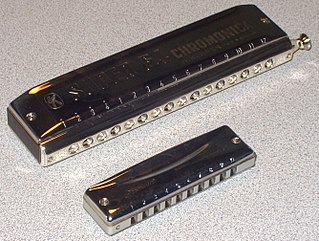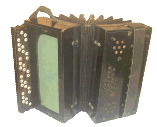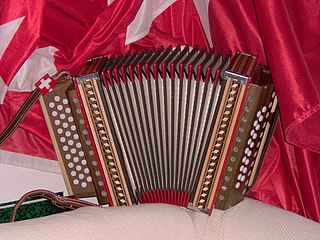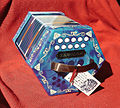
Accordions are a family of box-shaped musical instruments of the bellows-driven free-reed aerophone type, colloquially referred to as a squeezebox. A person who plays the accordion is called an accordionist. The concertina and bandoneón are related. The harmonium and American reed organ are in the same family, but are typically larger than an accordion and sit on a surface or the floor.

The harmonica, also known as a French harp or mouth organ, is a free reed wind instrument used worldwide in many musical genres, notably in blues, American folk music, classical music, jazz, country, and rock. The many types of harmonica include diatonic, chromatic, tremolo, octave, orchestral, and bass versions. A harmonica is played by using the mouth to direct air into or out of one holes along a mouthpiece. Behind each hole is a chamber containing at least one reed. A harmonica reed is a flat, elongated spring typically made of brass, stainless steel, or bronze, which is secured at one end over a slot that serves as an airway. When the free end is made to vibrate by the player's air, it alternately blocks and unblocks the airway to produce sound.

A concertina is a free-reed musical instrument, like the various accordions and the harmonica. It consists of expanding and contracting bellows, with buttons usually on both ends, unlike accordion buttons, which are on the front.

An autoharp or chord zither is a string instrument belonging to the zither family. It uses a series of bars individually configured to mute all strings other than those needed for the intended chord. The term autoharp was once a trademark of the Oscar Schmidt company, but has become a generic designation for all such instruments, regardless of manufacturer.

The English concertina is a member of the concertina family of free-reed musical instruments. Invented in England in 1829, it was the first instrument of what would become the concertina family.

A Chemnitzer concertina is a musical instrument of the hand-held bellows-driven free-reed category, sometimes called squeezeboxes. The Chemnitzer concertina is most closely related to the bandoneón, more distantly to the other concertinas, and accordions.

The garmon, is a kind of Russian button accordion, a free-reed wind instrument. A garmon has two rows of buttons on the right side, which play the notes of a diatonic scale, and at least two rows of buttons on the left side, which play the primary chords in the key of the instrument as well as its relative harmonic minor key. Many instruments have additional right-hand buttons with useful accidental notes, additional left-hand chords for playing in related keys, and a row of free-bass buttons, to facilitate playing of bass melodies.

Hohner Musikinstrumente GmbH & Co. KG is a German manufacturer of musical instruments, founded in 1857 by Matthias Hohner (1833–1902). The roots of the Hohner firm are in Trossingen, Baden-Württemberg. Since its foundation, and though known for its harmonicas, Hohner has manufactured a wide range of instruments, such as kazoos, accordions, recorder flutes, melodicas, banjos, electric, acoustic, resonator and classical guitars, basses, mandolins and ukuleles

The Richter-tuned harmonica, or 10-hole harmonica or blues harp, is the most widely known type of harmonica. It is a variety of diatonic harmonica, with ten holes which offer the player 19 notes in a three-octave range.

A button accordion is a type of accordion on which the melody-side keyboard consists of a series of buttons. This differs from the piano accordion, which has piano-style keys. Erich von Hornbostel and Curt Sachs categorize it as a free reed aerophone in their classification of instruments, published in 1914. The sound from the instrument is produced by the vibration of air in reeds. Button accordions of various types are particularly common in European countries and countries where European people settled. The button accordion is often confused with the concertina; the button accordion's buttons are on the front of the instrument, where as the concertina's are on the sides and pushed in parallel with the bellows.

The Flutina is an early precursor to the diatonic button accordion, having one or two rows of treble buttons, which are configured to have the tonic of the scale, on the "draw" of the bellows. There is usually no bass keyboard: the left hand operates an air valve. A rocker switch, called a "bascule d'harmonie" is in the front of the keyboard. When this switch is thumb activated, it would open up a pallet (a pad that covers a tone hole, at the other end of the key button, for a simple Tonic/Dominant drone: Tonic on the draw and Dominant on the press, e.g. Tonic notes C/g, and Dominant G/d, without any major or minor thirds.

A melodeon or diatonic button accordion is a member of the free-reed aerophone family of musical instruments. It is a type of button accordion on which the melody-side keyboard contains one or more rows of buttons, with each row producing the notes of a single diatonic scale. The buttons on the bass-side keyboard are most commonly arranged in pairs, with one button of a pair sounding the fundamental of a chord and the other the corresponding major triad.
The chromatic harmonica is a type of harmonica that uses a button-activated sliding bar to redirect air from the hole in the mouthpiece to the selected reed-plate desired. When the button is not pressed, an altered diatonic major scale of the key of the harmonica is available, while depressing the button accesses the same scale a semitone higher in each hole. Thus, the instrument is capable of playing the 12 notes of the Western chromatic scale. The chromatic harmonica can thus be contrasted with a standard harmonica, which can play only the notes in a given musical key.

A Schrammel accordion is an accordion with a melody keyboard in the chromatic B-Griff system and a twelve-button diatonic bass keyboard. It is named for a traditional combination of two violins, accordion or clarinet, and contraguitar known as a Schrammelquartet – a group that played Schrammelmusik in the Vienna chamber music tradition.

Tremolo harmonicas are a type of harmonica, distinct by having two reeds per note. In a tremolo harmonica the two reeds are tuned slightly off a reference pitch, one slightly sharp and the other slightly flat. This gives a unique wavering or warbling sound created by the two reeds being not exactly in tune with each other and difference in their subsequent waveforms acting against one another. The degree of beating can be varied depending on the desired effect. Instruments where the beating is faster due to the reeds being farther apart from the reference pitch are called "wet", whereas those where the beating is slower and less noticeable due to the reeds being more closely in tune are called "dry".

The Schwyzerörgeli is a type of diatonic button accordion used in Swiss folk music. The name derives from the town/canton of Schwyz where it was developed. Örgeli is the diminutive form of the word Orgel (organ). Outside of Switzerland the instrument is not well known and is hard to find.

The Stradella Bass System is a buttonboard layout equipped on the bass side of many accordions, which uses columns of buttons arranged in a circle of fifths; this places the principal major chords of a key in three adjacent columns.

The Steirische Harmonika is a type of bisonoric diatonic button accordion important to the alpine folk music of Slovenia, the Czech Republic, Austria, the German state of Bavaria, and the Italian South Tyrol. The Steirische Harmonika is distinguished from other diatonic button accordions by its typically richer bass notes, and by the presence of one key per scale row that has the same tone on both compression and expansion of the bellows, called a Gleichton. The bass notes earn the distinction Helikonbässe because they use bigger reeds with duralumin reed frames and a special chamber construction that amplifies its bass tones to give it a loud sound reminiscent of a Helicon tuba.

Khromka is a type of Russian garmon. It is the most widespread variant in Russia and in the former USSR. Nearly all Russian garmons made since the mid of the 20th century are khromkas.

The Duet concertina is a family of concertinas, distinguished by being unisonoric and by having their lower notes on the left and higher on the right.






















